Telling stories is a unique human trait. No other species is able to use language in such a refined form. Stories can have a huge impact, but this can only be achieved if enough people collectively believe in them. This also applies to stories about companies or organisations. Every day new companies are created and others go bankrupt. Through mergers, acquisitions and reorganisations, the story of a company becomes something different every time. Technological developments mean that stories have to be adapted. Companies can direct the way their stories are published, for example by advertising or publishing a press release. A directed message, however, has little persuasive power if it is does not match the stories that people tell each other. It is therefore essential that employees and customers believe in the story and that they spread it in a positive way.

This applies just as much to commercial companies as to educational institutions, hospitals, municipalities and other non-profit organisations. It applies to multinationals, but also to start-ups, freelancers and even to individual employees. The degree of success achieved as a person, as a team and as an organisation depends to a large extent on the stories that are told. Every day, wonderful stories are created everywhere. However, they often go unnoticed. They are taken for granted and not valued, let alone shared. This article is about triggering and spreading positive stories through the natural dynamics of enthusiasm. For the record: When I talk about organisations or brands, it could just as easily refer to commercial businesses, products, services, government authorities, teams or individuals. Stories are important everywhere.
The dynamics of enthusiasm
Positive stories are actually ships that sail on the dynamics of enthusiasm. Without enthusiasm, a story lacks conviction. It is like a ship that is lying high and dry on the quay and does not move from its place. To understand the dynamics of enthusiasm I use the classification described in the Enthusiasm Trilogy: Flame, Flow and Flood. In the rest of this article I will discussthese elements in relation to storytelling. Each timeI’ll briefly describe one of the elements of the dynamics of enthusiasm (Flame, Flow & Flood) and then I deal with two business cases from my own practice per element.
The Flame: the Olympic fire
Flame represents the burning heart of the core story. It is the source of enthusiasm for the organisation or brand. It is the essence of an organisation from which stories arise. These stories, in turn, fuel the Flame. In music we call it the ‘soul’ of the musician. It is quite elusive, yet every music lover knows what it means. An enthusiastic entrepreneur or a passionate professional also has a recognisable Flame. An organisation floats on a joint Flame: the essential story that employees and customers are enthusiastic about. So the Flame represents the Olympic fire of the organisation, as it were. And when an organisation grows, the fire must continue to burn. This can sometimes be quite a challenge, especially when there are ongoing reorganisations and job insecurity.
Non-commercial organisations have a Flame that is usually directly related to their added value in social terms. Hospitals aim to make people healthy and educational institutions provide general development and a better future perspective. Commercial organisations want to make customers enthusiastic about their products or services. The stories that show that this objective has been achieved are fuel for the Flame. Examples are patients who have been received good care, alumni who are grateful for the knowledge gained and consumers who are happy with their product. It is important to tell these stories, to collect them and to spread them. Success stories, enthusiastic customers or employees are rarely given a structural place in the business. That is a pity because these stories can make an important contribution to employee motivation, customer enthusiasm and the achievement of strategic objectives. In my first book “The Superpromoter” I have already stressed the importance of employee customer enthusiasm, especially in a connected world in which stories are spread with lightening speed.
Business case: Canon
A company that operates from a Flame, anchored in its origins, is Canon. The Japanese multinational has a corporate philosophy that can be summed up in the Japanese word Kyosei, which stands for ‘working together and living for the common good’. This philosophy forms the core of all its activities and sponsorship. Canon makes products that serve the public interest. The company is best known for its printers and photo cameras, but it makes surveillance cameras and medical equipment as well. The company also demonstrates its social commitment through all kinds of sponsorship activities. For example, the company funds a charity, the Canon Foundation, which is committed to improving understanding and cooperation between Europe and Japan. The foundation provides grants to European scientists who want to carry out research in Japan and Japanese scientists who would like to go to Europe (see photo).
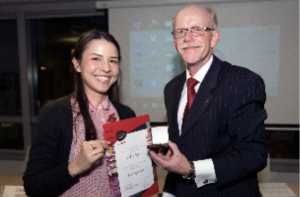
In short, there are plenty of good stories to tell about Canon’s Flame. And we haven’t even mentioned the stories of customers or employees who do or experience great things every day. However, even within Canon it is not yet customary to share these stories with each other. I myself was able to provide Storytelling training for Canon’s European management. It soon became clear that the participants had enough stories on hand. Their biggest challenge is to encourage their employees to recognise and share Flame stories with their colleagues and customers. Ruta Jonuseviciute has incorporated the subjects discussed in the training into the drawing below.
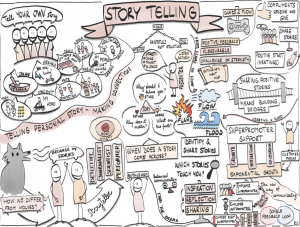
“There has been more attention paid to storytelling in recent years”, says Gerard Pieterse, Director of People Development at Canon Europe, “but we hope that sharing enthusiastic stories will permeate even further into the culture”. They are placing emphasis on this by offering storytelling training courses and by putting it on the agenda of various events. Soon these courses will also be offered online so that even more people can be reached. Pieterse concludes that storytelling has also become central to the propositiontotheir customers. “‘Live for the Story’ has even become the tagline for the company’s value proposition. Ultimately everything Canon does is designed to capture, share and present business and personal stories and images.”
Business case: De Vijverhof care home
In many companies, a mission statement is drawn up by the corporate communications department after the management spent a day out of the office brainstorming. It must be a message that everyone agrees with and one that appeals to customers and employees. Despite the good intentions, the final message is often stripped of all personality and fire. It often results in generalities like “We go for quality” or “We aim for satisfied customers”. Impersonal statements nobody can object to, but which also radiate very little energy and have no distinctive character. A mission statement like that only comes to life when it is supplemented with the underlying stories. Personal stories of employees, customers and other stakeholders. An important role is reserved for the management of the company. If they can express their intrinsic motivation in a personal story, they pave the way for colleagues to think about their own Flame. A manager who has taken up this challenge is Sander van IJsseldijk, director of the board of De Vijverhof, a care home for the elderly in Capelle aan den IJssel. He shared his story in De Vijverhof’s internal magazine and in a Dutch National Newspaper (AD) on 26 August 2018. Here is a fragment:
From an early age I have felt a connection with the elderly. Unfortunately I never knew my grandpas, but both grandmothers had an important place in our family. Every Sunday we went to ‘grandma Ronssehof’,who lived in care home the Ronssehoffor more than 25 years!
Ourother grandmother was a teacher. She unfortunately fell victim to dementia and ultimately couldn’t manage at home any more. The house next door became vacant in that period and my grandmother moved there so that my mother could take care of her. A passageway was made between the houses and I was given a room upstairs with my grandmother. It was cosily full in her place with all kinds of plants and flowers. She also liked to make creative things out of branches and sticks. I can rememberchatting with her in the living room or in the hallway downstairs before I went to my room to do homework.

And here we are. Together on the picture taken in front of the house. I loved my grandmother very much and feel deeply connected to her. For my parents it was an intensive period of informal care. I have great admiration for my parents for the way they provided care and support for many years, with dedication and love. Both my grandmothers are still in a picture frame on my desk. In this way they continue to help me make the right choices with difficult dilemmas. They symbolise what I want to stand for: loving care, attention and connectedness.
Sandervan IJsseldijk
Flow: Sharing and listening
A good interaction between the storyteller and the audience creates a form of flow. The enthusiasm of the narrator then spreads to the listeners and they show their appreciation. It can be compared to achieving harmony in music. The speaker experiences attention and appreciation and is therefore encouraged to tell further. But if the storyteller is ignored, the story falls flat. In extreme cases, people walk away or turntheir backs to the speaker.Listening without responding is anotherform of ignoring. The online version of this is when no one reacts to a blog or a post on social media. In those momentsnobody seems interested. Even mild forms of attention can cause Flow. This already happens when a listener nods or shows sincereinterest. Asking questions, giving compliments or applauding are more pronounced forms of positive attention. The online equivalentsare responses, retweets or likes.
Organisations cannot impose enthusiasm for storytelling, but the management can create favourable conditions and provide encouragement. People are natural storytellers and almost everyone shares stories in private situations. It is important to tap into this natural potential. People need to feel safe and sometimes need some encouragement. An effective way to stimulate the dynamics of enthusiasm and create flow is to take the potentially enthusiastic storytellers away from their daily environment to first come into their element together. Strengthened by the stories and the support of other enthusiasts, they are more likely to convince colleagues in their own department. Together they can then bring about a change in culture.
A cultural change like this was noticeable in training programmes for various financial service providers such as SNS Bank (now Volksbank), Reaal (now Vivat), ABN AMRO, Rabobank and Nationale Nederlanden, where 15 to 25 enthusiastic employees were taken out of their daily environment for a number of days. In the safe company of other positive colleagues, these employees were able to blossom, and to encourage and inspire each other. Strengthened by the support of the group, many employees were then able to get their colleagues aboardand cause a positive turnaround intheir own department. An important success factoris bringing together these employees regularly so that they can share stories and continue to encourage and inspire each other. Below I describe two cases where companies have used storytelling in their ownway to bring theirorganisation into flow. At Stedin, employees were supported in spreading their enthusiasm and at BSH, customer stories were used to generate flow.
Business case: Stedin
Organisations can stimulate storytelling within their organisation by encouraging and offering a podium to storytellers who are already active. For example, grid network operator Stedin has a group of employees who have accepted the invitation to become a ‘brand builder’, a kind of ambassador or superpromoter of the organisation. They have been trained in storytelling and are deployed to tell stories about working at Stedin or to reinforce Stedin’s sustainable ambitions.
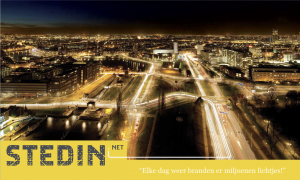
Senior communications advisor, Heidi Nachtegaal, indicates that the platform they use for thispurposeis not yet perfect, but that the stories are already appearing. Managers have also received training to understand the importance of storytelling and to be able to tell stories themselves. For example, there is a story about a young woman who started in the call centre and worked herself up to become co-responsible for the corporate strategy. Another popular feature is the series ‘coffee with Kevin’, in which a colleague visits co-workers in the field, for example the technicians, and reports on their meeting. All these stories help to demonstratewhat Stedin stands for. By supporting colleagues, more stories are told and shared. It is also very important that colleagues encourage each other. This creates the much-needed feeling of safety whilethe positive feedback creates Flow.
Business case: BSH
BSH Household Appliances, the parent company of the Bosch and Siemens brands, has been conducting research among its customers for many years. Since its launch in 2014, 26 countries have successfully rolled out the NPS (Net Promoter Score) system. For instance China, USA, the entire Asian Pacific, all Scandinavian and a large number of European countries and a part of Latin America. The Eastern European countries, Hong Kong, Taiwan and Turkey are on the 2018/2019 roadmap ready to start their NPS journey. NPS is used qualitatively at BSH in the orientation phase, after purchase of the household appliance and in use, and of course for Customer Service.

After a technician has visited the customer for a repair, the customer is asked if they would recommend the company based on this experience. The NPS score is based on this question. Because the company wants to excel in customer focus, this score is highly valued. However, a score like this is not always enough to get colleagues within the organisation moving. It is not easy for people to be triggered by numbers, but they can be moved by stories to take action. Together with Izaac van Kralingen, theNPS Officer responsible for the NPS implementation worldwide, we have started a project to create Storytelling from the NPS data. The open-answer categories from the study could be used for this purpose. After the recommendation question (NPS), open questions are also asked about what went well and what could be improved. Consumers take the opportunity to share their experiences extensively with BSH in these open fields. They note down their annoyances or describe how they were positively surprised. If someone explains expressively that they get into a quarrel with the neighbours because the washing machine makes too much noise, or are so enthusiastic about an appliance that they proudly show it to the whole neighbourhood, it is possible to step into the shoes of the customer. This feedback creates the necessary flow to implement improvement and to learn from what is going well. In the case of BSH, the cold NPS data is enriched with stories and this is what gets people moving.
Flood: Spreading stories
A story doesn’t come to life until it spreads. When a story is widely shared Ispeak of Flood. In music, this is the moment that the concert hall goes crazy and everyone is singing along. In the digital age, Flood can also be seen when a song spreads through Youtube or Spotify. For an organisation, this means positive stories from employees and customers spreading and products and services being recommended. In recent decades, the opportunities to spread stories have rocketed. In the past, people depended on spoken or written contact, but in the digital age, stories can spread rapidly and exponentially via the internet. The fact that these possibilities exist does not mean that organisations make optimum use of them. Especially in large organisations, people want to keep control over the communication to the outside world, and this slows down rather than encourages the enthusiasm to share stories. Yet more and more organisations are aware that the enthusiasm of employees and customers positively influences the image of an organisation. It therefore makes sense to consider ways of supporting the spread of this enthusiasm. Two cases are discussed below. The RVO case describes how the Netherlands Enterprise Agency (RVO) supports employees in sharing stories and the DTG case shows how this company gives customers the opportunity to tell their story.
Business case RVO.nl
The Netherlands Enterprise Agency (RVO.nl) is a Dutch government agency which stimulates entrepreneurs in sustainable, agricultural, innovative and international business.RVO.nl supports employees in sharing stories via internal and external social media. The RVOfan was launched in October 2017. With this programme RVO.nl helps and encourages its employees to work with social media in an easy, safe and fun way. The organisation uses Smarp, a tool that allows employees to easily share content on their own social media profile. An editorial team provides a fresh selection of shareable content on a daily basis. In addition, employees can easily put forward something themselves – for example a relevant article they have read – by calling on colleagues to share it. After a year there are about 400 active users (10% of the total number of employees) who together have generated almost 6,000 shares and 11,000 ‘clicks’ to the RVO.nl website.
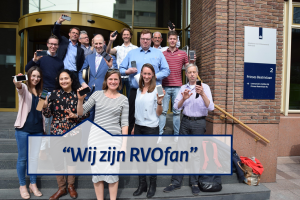
Suze Krijnen, Employee Advocacy & Community Manager at RVO.nl, sees a genuine motivation in many colleagues to tell their network about the work of RVO.nl. They share tips for entrepreneurs, but also show how the government contributes to solving societal challenges, such as the Sustainable Development Goals, with funding, advice and the right contacts. Whereas in the beginning the share button was sometimes pressed tooeagerly, more and more employees are choosing a subject in which they are experts, or in which they are truly interested.By sharing this knowledge they raise their profile. There are employees who mainly share messages about the energy transition or about intellectual property. Some of them even started to blog about these subjects. Another colleague knows all about doing business with the UK, and regularly appears in the media to educate entrepreneurs about the consequences of the Brexit. The RVOfan platform provides these employees with a platform throughwhich they can reach even more people. In this way RVO.nl increases awareness of its products and services and the organisation acquires a more human face. At the same time, colleagues say they feel more connected to their rather large and complex organisation and to each other. Thanks in part to RVOfan, members of the management have also become more active on social media. They share information themselves but also like and respond to messages from colleagues. This exemplary behaviour and the encouragement from the management contributes to a safe culture, where enthusiasm can blossom.
Business case: DTG
Another way to support the dynamics of enthusiasm is to collect customer stories. A company that has used this approach successfully is DTG. Years ago, the company faced a major challenge to transform from an ‘advertisement seller’ for their printed phone books (the Dutch Yellow pages) to an ‘online marketing advisor’ for Small and Medium Enterprises. The deeper Flame could however remain the same. The company’s mission was still to make small and medium-sized businesses findable for their customers. However, the way to do this had changed radically. The company no longer only offered space to advertise in a phone book that landed on the doormat every year, but it offered digital services such as website building, search engine optimisation and online customer interaction. During this period it also changed the name to DTG, a brand without any connotations. So a great deal had to be done to involve customers and employees. In this process, DTG placed the stories of customers at the centre of its efforts. For the transformation to succeed, it was essential for customers to be enthusiastic about the new products and services. Fortunately, there was no lack of enthusiasm. DTG started phoning customers to explain the new positioning and name change. Mo, a shoemaker from Amsterdam, was one of the customers who became very enthusiastic about DTG’s support in the area of online marketing. By now he has become an icon for DTG because he has added hundreds of new customers. DTG has supported his enthusiasm by literally visualising his story. In DTG’s advertising, Mo tells the story of the growth of his shoe shop. Indirectly, it is clear that DTG has contributed significantly to this growth by making the business easier to find online. Mo’s video can be seen here https://www.youtube.com/watch?v=1yBPdlOKduI.
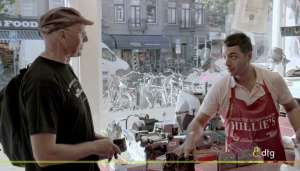
The video of Mo is a few years’ old now. In the meantime other videos of a baker and a physiotherapist have been added. Gaya Helder, Customer Experience Director at DTG, explains that they are currently working on another repositioning. This new positioning will once again focus on the customer, but there is also plenty of attention for employee stories and the Flame of the management. The idea is that every month the proud story of a customer, an employee and a manager will be shared. Stories are also retrieved from interviews with employees and the NPS system. So in the new transformation enthusiastic stories will once again play a central role.
In conclusion
Several examples have been discussed above which show how Storytelling can be used to stimulate the dynamics of enthusiasm within an organisation. The higher goal of an organisation (Flame) can be brought to life through stories and gain broad support. Positive stories also generate employee motivation and an increase in customer focus (Flow). In order to strengthen the reputation of an organisation or to attract new customers, it is important that these stories also spread (Flood). This article covers all these elements. It shows how an ancient human characteristic can be tapped into and revived, with or without the help of modern technology.
Rijn Vogelaar provides Storytelling training courses. Information about courses can be found here. If you would like to receive more information, please let us know via the contact form.
